Australia So Much to See


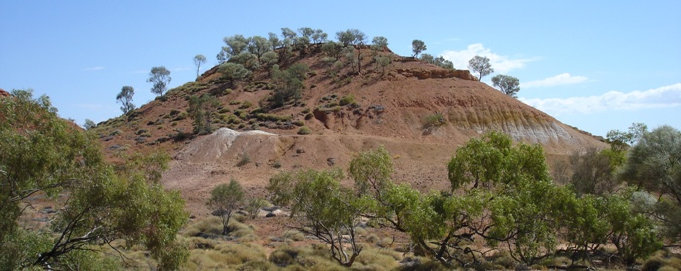
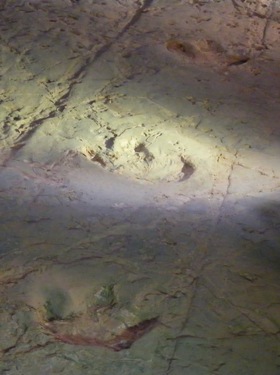
While local station owner Glen Seymour was fossicking for opals on the hill that now bears him name, he discovered a fossilised bone. This alone was not a startling discovery, but nearby he uncovered a footprint. Following showing it to a station employee who
believed it to be a dinosaur print, the sample was sent to the
During 1971 a panel of experts ascertained that the incline with the prints would have continued past a present creek line and
into the next hill. Subsequent excavations found perfectly preserved prints of three different species. The most successful
dig was overseen by Doctor Mary Wade, and over a ten year period an elderly man by the name of Malcolm Lark was a consistent worker. Doctor Wade named
International research has taken place and by making comparisons with other trackways and fossil discoveries around the world, calculating
the size of the animals. They have also calculated the speed of the predator as the footprints dug deeper into the muddy surface
at the water’s edge. The predator left eleven tracks preserved in the mud, taking steps up to two metres long, leaving three
toed prints up to 58 centimetres long. The distance between the prints indicates it was walking at about eight to nine kilometres
per hour. After six steps it shortened its paces showing that it slowed to about six kilometres per hour. Strides one
to six are about sixty centrimetres long, but footprint seven is only forty centimetres. At the tenth step, the large theropod
had begun to turn right. It took one more step and then its tracks are lost. What happened after this is impossible to say because
the side of the creek has been eroded away.
There were three species present at the water’s edge, with adults and young included. Many small chook sized creatures called coelurosaurs were present, panicking and running around, as were a number of sheep sized dinosaurs
called ornithopods. All these dinosaurs stood, walked on hind legs and ran on their toes, much like birds do. This type of movement
is called digitigrade.
It is evident that the small dinosaurs were running because the length between successive steps is greater
than leg length. These coelurosaurs moved at about nine to fifteen kilometres per hour and ornithopods at about ten to thirty kilometres
per hour. The small dinosaurs crossed the quarry area in a fairly uniform spread so it is probable they were running from the big
theropod.
See more about the Lark Quarry story at Lark Quarry Dinosaur Trackways
and Lark Quarry Dinosaur Stampede
Winton - We visit Lark Quarry, where the only dinosaur stampede in the world has been discovered in trackways
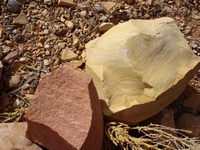
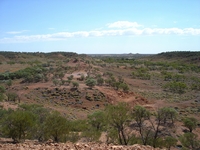
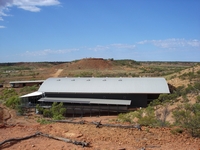
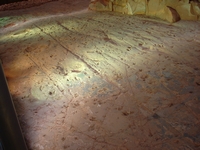
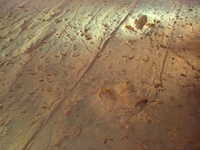
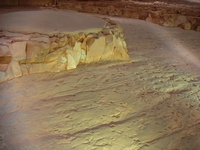
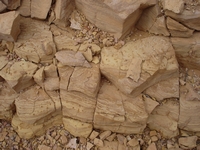
The site where the Lark Quarry footprints were found was once a stream bed leading into a lake. Scientists believe that the water
level in this creek dropped, exposing a patch of half-dried, still pliable mud on one side.
Once the tracks were uncovered,
relentless heat and occasional rain storms eroded the exposed ‘soft’ solidified powdery mud, so a roof was erected in 1979. Kangaroos found this an ideal shelter, and tourists walked across the prints causing further degradation.
The present climate controlled building was erected in 2002 using Government funding of $2.5 million; this being allocated for the
preservation and presentation of Lark Quarry as part of the Queensland Heritage Trails Network initiative. This building was
insulated by mud brick walls, using removed rubble to form the bricks and create a climate controlled environment. The complex
was officially opened on 18th August 2002, however following the collapse of one of the mud brick walls, it remained closed from 30th October
2002 to 11th April 2003.
Similarly in October 2011 instability in a wall caused the trackways to be closed to the public
until 5th April 2012. Funding is being sought to do further preventative maintenance on the building.
In 2004, the site
was placed on the National Heritage List.
Countless studies have been done on this site – the only stampede scene discovered
anywhere in the world. Visitors to Lark Quarry can be a part this unique experience. Whereas other dinosaur trackways
have been uncovered, only here there is evidence of a chase. This dinosaur stampede in part inspired Steven Speilberg’s story
of
The fact the footprints were preserved in the drying mud at the water’s edge rather than just washed away is one uncommon occurrence. Covered and protected for around 95 million years, and by chance discovered by a station manager to be excavated by a paleontology
team is another. We are indeed fortunate to have this discovery made in our lifetime, and have the opportunity of sharing in
the 95 million year old story.
Glen Seymour also found a fossilised crocodile in a creek bed on his property, and his son is trying to re-locate it. A number
of one to one and a half metre crocodiles have been found in the wider region and these are believed to be ancestors of present day
crocodiles. The discovery of a complete skeleton without the snout, and another skull near Isisford, has placed